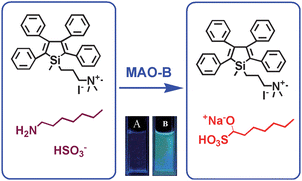A direct continuous fluorometric turn-on assay for monoamineoxidase B and its inhibitor-screening based on the abnormal fluorescent behavior of silole†
Abstract
As essential enzymes in the body, monoamine oxidases (MAOs), including

* Corresponding authors
a
Beijing National Laboratory for Molecular Science, Organic Solids Laboratory, Institute of Chemistry, Chinese Academy of Sciences, Beijing 100190, China
E-mail:
dqzhang@iccas.ac.cn
b Graduate School of Chinese Academy of Sciences, Beijing 100190, China
As essential enzymes in the body, monoamine oxidases (MAOs), including

 Please wait while we load your content...
Something went wrong. Try again?
Please wait while we load your content...
Something went wrong. Try again?
L. Peng, G. Zhang, D. Zhang, Y. Wang and D. Zhu, Analyst, 2010, 135, 1779 DOI: 10.1039/C0AN00168F
To request permission to reproduce material from this article, please go to the Copyright Clearance Center request page.
If you are an author contributing to an RSC publication, you do not need to request permission provided correct acknowledgement is given.
If you are the author of this article, you do not need to request permission to reproduce figures and diagrams provided correct acknowledgement is given. If you want to reproduce the whole article in a third-party publication (excluding your thesis/dissertation for which permission is not required) please go to the Copyright Clearance Center request page.
Read more about how to correctly acknowledge RSC content.
 Fetching data from CrossRef.
Fetching data from CrossRef.
This may take some time to load.
Loading related content
